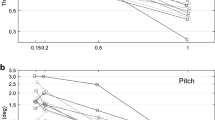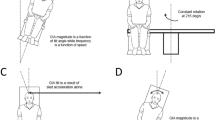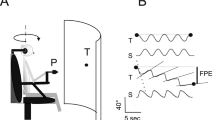Abstract
Head tilt is a rotation of the head relative to gravity, as exemplified by head roll or pitch from the natural upright orientation. Tilt stimulates both the otolith organs, owing to shifts in gravitational orientation, and the semicircular canals in response to head rotation, which in turn drive a variety of behavioral and perceptual responses. Studies of tilt perception typically have not adequately isolated otolith and canal inputs or their dynamic contributions. True tilt cannot readily dissociate otolith from canal influences. Alternatively, centrifugation generates centripetal accelerations that simulate tilt, but still entails a rotatory (canal) stimulus during important periods of the stimulus profiles. We reevaluated the perception of head tilt in humans, but limited the stimulus to linear forces alone, thus isolating the influence of otolith inputs. This was accomplished by employing a centrifugation technique with a variable-radius spinning sled. This allowed us to accelerate the sled to a constant angular velocity (128°/s), with the subject centered, and then apply dynamic centripetal accelerations after all rotatory perceptions were extinguished. These stimuli were presented in the subjects’ naso-occipital axis by translating the subjects 50 cm eccentrically either forward or backward. Centripetal accelerations were thus induced (0.25 g), which combined with gravity to yield a dynamically shifting gravitoinertial force simulating pitch-tilt, but without actually rotating the head. A magnitude-estimation task was employed to characterize the dynamic perception of pitch-tilt. Tilt perception responded sluggishly to linear acceleration, typically reaching a peak after 10–30 s. Tilt perception also displayed an adaptation phenomenon. Adaptation was manifested as a per-stimulus decline in perceived tilt during prolonged stimulation and a reversal aftereffect upon return to zero acceleration (i.e., recentering the subject). We conclude that otolith inputs can produce tilt perception in the absence of canal stimulation, and that this perception is subject to an adaptation phenomenon and low-pass filtering of its otolith input.
Similar content being viewed by others
Author information
Authors and Affiliations
Additional information
Received: 27 February 1997 / Accepted: 2 September 1997
Rights and permissions
About this article
Cite this article
Seidman, S., Telford, L. & Paige, G. Tilt perception during dynamic linear acceleration. Exp Brain Res 119, 307–314 (1998). https://doi.org/10.1007/s002210050346
Issue Date:
DOI: https://doi.org/10.1007/s002210050346




